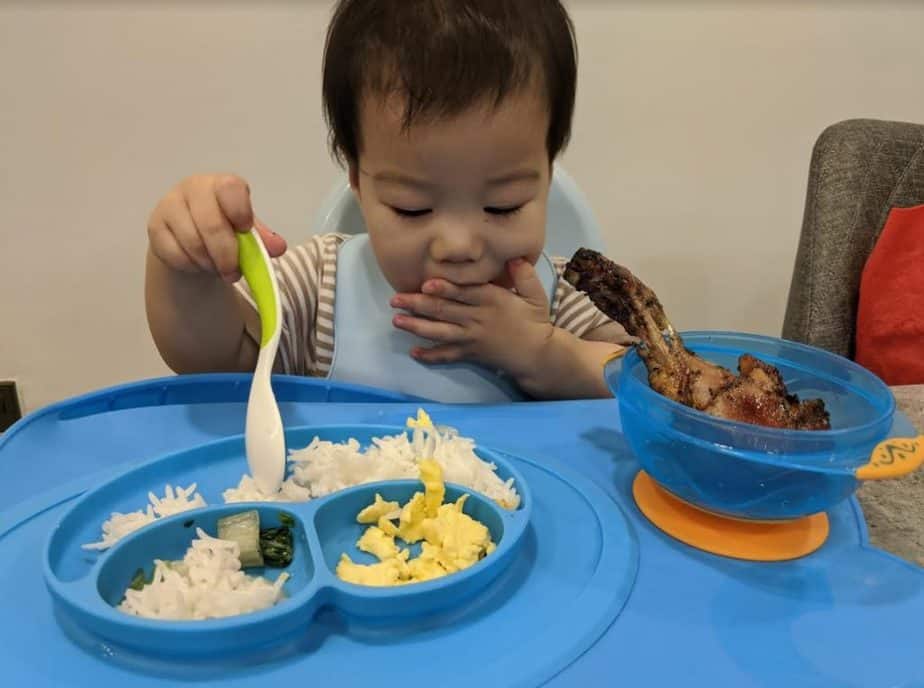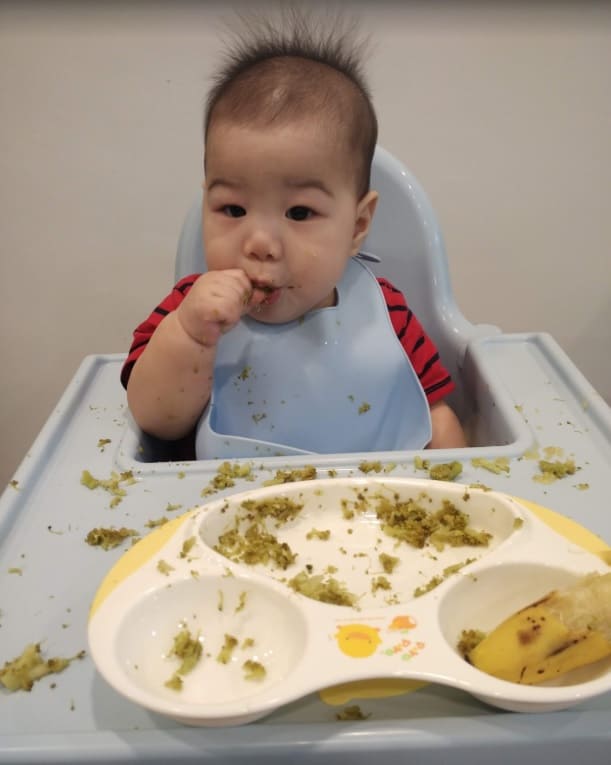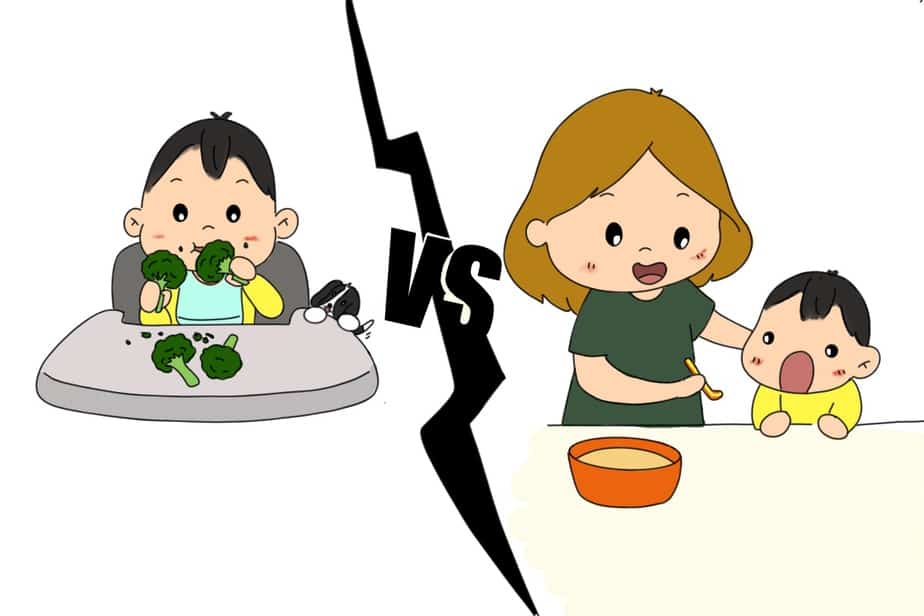As our boy grew to six months old, we started to give him solids. The question, though, is should we start baby-led weaning or go with the tried and true traditional weaning? Well, we tried both methods and have found the pros and cons of each.
So which is better? Baby-led weaning or traditional weaning? Baby-led weaning is better if you can handle the mess because it helps your baby develop his fine-motor skill, hand-eye coordination, and sensorial skill. Traditional weaning is better if you want a cleaner and faster meal.
That’s the quick answer, but let’s take a deeper look before we decide which is better. There are already many articles stating the benefits and challenges of both methods, and so I won’t be covering theories. The things I’m writing are what I can see and observe from my son, children at the kindergarten I teach, and other children around me.
The benefits we saw from BLW
I saw some excellent benefits when my son started BLW. The benefits are not instant, but over a while. We started BLW when he was six months old, and he is 18 months old now.
1. He has better hand-eye coordination
At the start, my son’s accuracy in picking up his food was low, his aim was off, and he would miss as he tries to pick it up. As he kept trying, he became more accurate and can now pick his food up without problems. Next is placing the food in his mouth. He would miss and place the food by the side of his mouth, with practice he eventually managed to put the food in.
There are many methods to train hand-eye coordination, but BLW stands out as I don’t have to train him purposely, he trains himself every day during meals.
2. He has a better pincer grip
One of the more important developments for babies is the pincer grip. A baby that uses BLW practice his pincer grip at every meal as they pick up their food.
People often comment that my son’s grip was stronger than other babies, I will attribute it to BLW. When my son was 16 months old, he can already pick up a clothespin with two fingers accurately in place and open it. Most children at the kindergarten I teach cannot do this at two years old, they lack the strength and skill, and it shows in their inability to hold a pencil properly.
My husband did a video earlier, you can see that persisting in BLW pays off. Like most BLW babies, Nate’s hand-eye coordination and pincer grip have developed to a level where he can eat by himself with little mess at just 15 months old.
3. He learns how to chew
Unlike puree, BLW requires babies to chew. That is why BLW babies develop better jaw muscles, and this sets them up for straighter teeth. [source]
As my son grows up, we don’t have to soften the food as much, he knows how to chew his food better than babies on puree. When I feed the children at the kindergarten, some children aged two will swallow their food before chewing properly because they never learned how to chew.
In one case, a child at four years old still could not chew his food and had to rely on blended food. Every child must begin to chew at some point, and since it’s already proven that children can chew their food before two years old, it is a good idea to train them sooner rather than later.
4. He can eat independently with the spoon
The first three benefits are the foundation for eating independently with the spoon. My son started to eat by himself with the spoon around a year old. He can feed himself and require little to no assistance, and our family can enjoy mealtime together.

When we go out for meals, other adults are usually surprised and impressed that he can eat by himself with the spoon. As a parent, I must admit that I feel very proud of my son every time someone compliments him 🙂
5. He learns how to differentiate what is edible and what is not
BLW babies eat many different kinds of food; they have much opportunity to explore their food by touch, smell, and know the color of the food. As they do that, they learn what can and cannot be eaten.
Once, I accidentally let a chicken bone go into his food, it was a small bone. To my surprise, he slowly took the bone out of his mouth and gave it to me. Since then I became more careful but also wasn’t so worried as he has proven that he knows what is edible and what is not. I later found out that it is common for BLW kids to remove non-edible stuff from their mouths.
6. He learns how to sit still during meals
I make sure I strap down my son on his high chair when he started BLW, and there are a few reasons for that.
The first reason is safety. He is eating solid food, and if he runs around, he may choke. Choking hazards are one of the concerns of BLW and sitting upright while having meals reduces that risk.
The second reason, it’s a very good way to contain the mess. If he runs around with his food, BLW will get a whole lot messier than it needs to be.
Because of those reasons, our son has learned to sit down on his chair when he has his meals. Today at 18 months old, he still does the same. He knows that he needs to sit on the chair before he can have his meal, and he doesn’t make a fuss about it during meal times. My friends who practice BLW say that their child doesn’t run around during meal times, while TW toddlers tend to run around. More on this in the TW challenges below.
The challenges we faced from BLW
BLW is not easy, and it requires persistence. I know many parents that drop out of BLW, and I’ll share some of the reasons here. Knowing the challenges of BLW is important as it can prepare you for what you’re going to face.
1. You will receive criticism and advice from other people
I want to put this first because I feel that this is the most detrimental to your persistence to continue BLW. Most people, likely including your parents, will not understand and agree to the methods of BLW, it’s just something new to many people.
My parents and in-laws were uncomfortable with BLW. They ask with concern why are we allowing our baby to eat with his hands and causing such a mess? Does he have enough to eat because most of the food doesn’t enter his mouth? They said they raised us with traditional weaning and we had no problems eating normally. Thankfully they were still supportive, even though they don’t use BLW when feeding our son. I have heard of many other of my friend’s parents who are against it.
I have some friends with babies that look like they are malnourished, either their baby is smaller in size, weights lighter or are shorter, and they practice BLW. Their parents, in-laws, relatives, and friends would voice their concerns, raise doubts about BLW, and give all kinds of advice. It’s common to hear gossips about their methods of raising their child.
Guess what? All of my friends that faced this criticism have healthy children, they proved that all their critics simply didn’t understand. Sure, they may be underweight or small, but many of these things may be hereditary and have nothing to do with their diets. I suggest joining a support group if you’re planning to start BLW, having support and affirmation from other parents will help you significantly on this journey.
2. You will be dealing with a lot of mess
BLW is going to be very messy, there’s no way around this. The good thing is it gets better as your baby learns how to eat. My son, like most babies, will spend most of his first few months exploring and playing with his food than actually eating it. Sometimes he will throw his food all over the place, causing more mess!

Be patient at this time, it’s part of the point of starting BLW in the first place. As his fine motor skills and hand-eye coordination improves, he can pick up his food and put it into his mouth with more accuracy, causing fewer drops and spillage over time.
Here is what I did to contain the mess. Check out the links to Amazon if you need to get one. The first is to get some silicone bibs. It will collect a lot of the food that will end up on his body. Next, get a splash mat, this way after meals, you can easily collect the spilled food and throw it away, and just wash the mat. The floor will remain clean. Lastly, get a suction plate to reduce the likelihood of him spilling his whole meal on the floor.
3. You will wonder if he has eaten enough
This is especially true in the first few months where most of the food is thrown around, mashed and squeezed, making it difficult to gauge how much he has actually eaten, and if you have a pet, your pet may end up eating a lot of the food that’s thrown around.
For me, that is fine. My husband and I are very clear that his main food is still breastmilk, and BLW is just a supplement. Eventually, solid food will fully replace milk. My son started to go fully on solids when he was a year old, and he was fully capable of feeding himself by then.
4. You will deal with some gagging, and some choking at the beginning
Gagging and choking are not exclusive to BLW; it can happen with any feeding methods. But chances of it happening to BLW babies tend to be higher due to the type of food they take. I highly recommend that every parent take a CPR course that also teaches you baby CPR so that you are ready and better equipped to face such situations.
Your baby can deal with gagging himself. Do not hit his back when he gags, it won’t help him but may cause the food to go deeper into his throat, increasing the likelihood of choking. Your baby will make sounds, cry, and cough when he gags, and his face may turn red. Don’t panic, be there to support and comfort him after that.
Choking, on the other hand, is dangerous and often fatal as the food gets stuck in the throat and cuts of air supply. He cannot cough, make noise, breath, and his face may turn purple. You need to act on this immediately. Here’s a helpful video on how to deal with gagging and choking, please watch it.
Now that you’ve watched the video, I highly recommend that you sign up for a first aid course. I attended a first aid course, and it taught me things that a video can never teach. For example, I was surprised at how hard I needed to hit the doll when doing back blows and chest thrusts, and I will never think to use that much force on my baby before the training.
The benefits we saw from TW
I practice BLW 80% of the time, and the remaining 20% I use the traditional weaning (TW) method. I can’t resist, Nathan is my firstborn, and I want the experience of hand feeding him! Other times, there are practical reasons why I choose TW, like when I’m in a rush, or when my parents and in-laws are taking care of him. Now let’s look at some of the benefits I saw from TW.
1. He finishes his meal much faster
Unlike BLW where he paces himself, in TW I control the pace, and every time he will finish his meals faster compared to BLW. Sometimes when I’m rushing for time, and I really cannot wait for him to finish his meal the BLW way, I spoon feed him.
2. We don’t have to deal with the mess
It comes without saying that TW is a lot easier because I don’t have to clean the floor, change his clothes, or wipe the high chair after he finishes his meal. I can’t help but feel relieved when I spoon feed him.
The drawbacks we saw from TW
Since I seldom spoonfeed my boy, I can’t see the drawbacks through him. But I teach in kindergarten, and these are my observation from children who practices TW at home.
1. They tend to run around while eating
When I’m at my parent’s place, sometimes I cannot practice BLW, and it’s just easier if I feed him directly. When he is not at his high chair, or if we do not designate a seat for him, he will take a bite, run around and come back for the next spoon. Not only is this a bad habit, but it also increases his chances of choking. I notice this in many TW toddlers.
When I visit friends and relatives that don’t practice BLW, the parents will chase after their toddlers to feed them, sometimes they will beg their toddler to stay put, sometimes even threatening to punish them if they don’t behave. That is a lot of work, and it’s tiring, and I think it can be avoided.
I’m not saying that TW is the cause. From what I observe, it is a lot harder to ask a TW toddler to sit down and eat, than for a BLW toddler to do the same thing. From my observation, I notice that BLW toddlers can sit still and eat because they are used to being strapped in during meals, and TW toddlers behave that way because parents tend not to strap them in and allow them to roam during meals.
2. They tend to find it hard to hold a pencil
To hold a pencil properly, your child needs to have a strong pincer grip. Many of my students find it difficult to hold a pencil, and when they can, their handwriting is usually bad. This is a sign of a bad pincer grip.
Sensory play is a fantastic way to improve a child’s fine motor skills and pincer grip. Not many parents know about this, and those who know may not practice sensory play at home. BLW babies have an advantage here because as they explore, touch, and pick up their food, they are developing their fine motor skills and pincer grip. TW babies lack this.
If you are practicing TW, I highly recommend that you expose your child to sensory play activities. There are sensory play centers you can enroll your child to, or you can buy sensory toys for him to play.
3. They don’t chew properly before swallowing
Parents or caregivers tend to feed puree to TW babies, and this can go on until they are 4-5 years old. A toddler that doesn’t learn how to chew will swallow his food after chewing only once or twice, sometimes skipping it altogether. When you are not directly preparing the food, you can’t control what they eat. None of the kindergarten I taught in feed puree to the students, and I have to teach them how to chew, something that can be taught at home.
If you practice TW or spoonfeed, prepare food that they need to chew and teach them how to chew from young, because the kindergarten or childcare you’re going to may not pay attention to your child when he eats, and may not realize that he doesn’t chew his food.
Final Verdict
Based on what I observe from my son, my friend’s children, and my students at the kindergarten, I notice that children that practice BLW have an advantage in writing skills, have better eating habits, and are more independent during mealtime. Because of that, I highly recommend starting BLW.
That said, BLW may not be suitable for everyone due to certain reasons and restrictions. I know that most parents and caretakers don’t even know what BLW is, so just practice TW. Look at me and you, most of us grew up with TW.
Related Questions
Do you let your baby feed himself at a restaurant? Yes, after he knows how to feed himself with the spoon. He still makes a mess, food will drop onto the floor, but it’s manageable, and I will pick up the food from the floor before I leave. Please don’t leave it to the restaurant workers to clean up. We should set good examples for our children by cleaning up after ourselves.
Is it too late to start BLW? No, you can start BLW any time you want.
Can I mix TW and BLW? Yes. BLW enthusiasts will disagree with this method; they call it TW with finger food (FF) instead. You can spoonfeed puree to your baby, and other times you can prepare finger food like cucumber and carrots and let them eat with the BLW method. Some may say that this method will confuse the baby, but I can’t find any evidence for this claim.
Some may even say that my 80/20 method is TW with FF, not BLW. I honestly don’t see a need to dive into technicalities and definitions. Both methods have their pros and cons. You’ve done your research, you have the information you need, so I encourage you to just do what is best for you and your baby.

